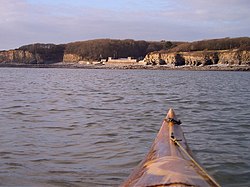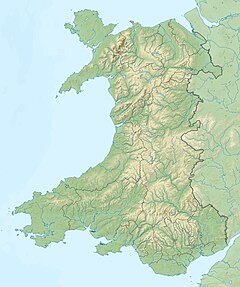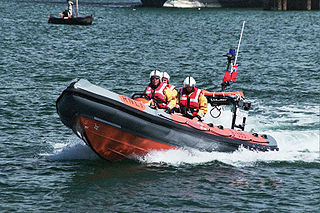
A rigid inflatable boat (RIB), also rigid-hull inflatable boat or rigid-hulled inflatable boat (RHIB), is a lightweight but high-performance and high-capacity boat constructed with a rigid hull bottom joined to side-forming air tubes that are inflated with air to a high pressure so as to give the sides resilient rigidity along the boat's topsides. The design is stable, light, fast and seaworthy. The inflated collar acts as a life jacket, ensuring that the vessel retains its buoyancy, even if the boat is taking on water. The RIB is an evolutionary development of the inflatable boat with a rubberized fabric bottom that is stiffened with flat boards within the collar to form the deck or floor of the boat.
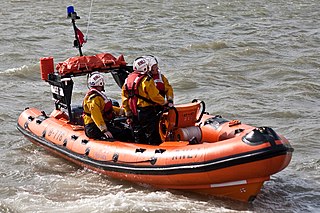
The Atlantic 75 is part of the B-class of lifeboats that serve the shores of the United Kingdom as a part of the RNLI inshore fleet.

The Atlantic 85 is part of the B-class of lifeboats that serve the shores of the United Kingdom and Ireland as a part of the RNLI inshore fleet.

The Atlantic 21 is part of the B class of lifeboats that served the shores of the United Kingdom and Ireland as part of the Royal National Lifeboat Institution (RNLI) inshore fleet. The Atlantic 21 was the first generation rigid inflatable boat (RIB), originated at and by Atlantic College in South Wales, the birthplace of the RIB after which the craft is so named. The school was also one of nine locations where the RNLI first established lifeboat stations using smaller inshore watercraft. Atlantic College Lifeboat Station was commissioned by the RNLI in 1963 and decommissioned in 2013.

The D-class (EA16) lifeboat is a class of inflatable boat operated since 1987 by the Royal National Lifeboat Institution of the United Kingdom and Ireland. It has been replaced operationally by the D-class (IB1), but many are still used as part of the relief fleet, as boarding boats for the larger classes of lifeboat and by the RNLI Flood Rescue Team.
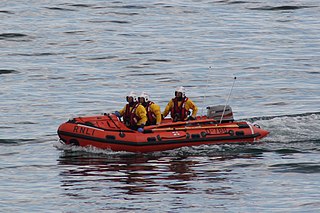
The D-class (IB1) lifeboats are inflatable boats serving in the RNLI inshore lifeboat (ILB) fleet as well as a number of Independent Lifeboats around the UK and Ireland. Although they are known as the "IB1" at times, they are the latest development of the D-class lifeboat and as such are mainly referred to as a "D-class".
Since its inception, the Royal National Lifeboat Institution (RNLI) has provided lifeboats to lifeboat stations in the United Kingdom and Ireland.
A rescue lifeboat is a boat rescue craft which is used to attend a vessel in distress, or its survivors, to rescue crew and passengers. It can be hand pulled, sail powered or powered by an engine. Lifeboats may be rigid, inflatable or rigid-inflatable combination-hulled vessels.

The Manchester Unity of Oddfellows was an Oakley-class lifeboat of the Royal National Lifeboat Institution (RNLI) stationed at Sheringham in the English county of Norfolk from 10 July 1961 until 1990 when she was replaced after 29 years service by an Atlantic 75 second generation Rigid Inflatable Boat (RIB) in May 1992. During the time that The Manchester Unity of Oddfellows was on station at Sheringham, she performed 127 service launches, rescuing 134 lives.

RNLB Lloyds II was an Oakley-class lifeboat of the Royal National Lifeboat Institution (RNLI) stationed at Sheringham in the English county of Norfolk from 8 October 1990 until April 1992, when she was replaced by the Atlantic 75 second generation Rigid Inflatable Boat (RIB) Manchester Unity of Oddfellows in April 1992. During the time that the Lloyds II was on station at Sheringham, she performed 13 service launches.
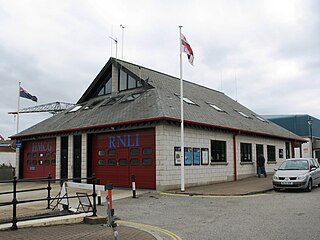
Falmouth Lifeboat Station is the base for Royal National Lifeboat Institution (RNLI) search and rescue operations at Falmouth, Cornwall in the United Kingdom. The first lifeboat was stationed in the town in 1867 and the present station was opened in 1993. It operates a Severn Class all-weather Lifeboat (ALB) and an Atlantic 85 inshore lifeboat (ILB).

Burnham-on-Sea Lifeboat Station is the base for Royal National Lifeboat Institution (RNLI) search and rescue operations at Burnham-on-Sea, Somerset in England. A lifeboat was stationed in the town from 1836 until 1930. The present station was opened in 2003. It operates two inshore lifeboats (ILBs), a B-Class rigid-inflatable boat and an inflatable D-Class.

Palling Volunteer Rescue Service was originally an independent, voluntary-staffed and charitably-funded inshore rescue service located in the village of Sea Palling in North Norfolk, England. First established by private funds in 1840, it was taken over by the Royal National Lifeboat Institution (RNLI) in 1858 and operated until 1931, when it was closed in a rationalisation of regional lifeboat stations. Revived in 1972 by local people through monies raised from private, business and charitable donations, today the renamed charitable Sea Palling Independent Lifeboat, runs a single 6.3 Ocean Pro RIB, an Arancia ILB and a shoreline rescue Argocat, all covering the area between Eccles-on-Sea and Winterton-on-Sea.
RNLB Manchester Unity of Oddfellows (B-702) was an Atlantic 75-class lifeboat rigid-inflatable inshore lifeboat on station at the English coastal town of Sheringham in the county of Norfolk in the United Kingdom. The boat was a permanent replacement for the Atlantic 21-class lifeboat RNLB B-536 which served at Sheringham from 29 January 1994.

St Abbs Lifeboat is an independent marine-rescue facility in St Abbs, Berwickshire, Scotland.

Hayling Island Lifeboat Station is a Royal National Lifeboat Institution station located on Hayling Island in the English county of Hampshire, on the eastern side of the island at the entrance to Chichester Harbour where it joins the major shipping route of the Solent, and is opposite the village of West Wittering. This major shipping route is busy at all times of the year and there are estimated to be 10,000 boats in the Chichester area alone. The Hayling Island station provides cover for the area 24 hours a day, all year, by means of two inshore rigid inflatable lifeboats placed on this station.

Portsmouth Lifeboat Station is located on Eastney Point near Southsea, in the English county of Hampshire. The station is owned and operated by the RNLI and is an Inshore lifeboat station. The station is facing Langstone Harbour on one of the tributaries flowing into the Solent. The station was established in May 1965.

Sandown Lifeboat Station is owned and run by Sandown and Shanklin Independent Lifeboat Service. It is located in the town of Sandown in the English county and island of the Isle of Wight.

Aberystwyth Lifeboat Station is a Royal National Lifeboat Institution (RNLI) lifeboat station in the coastal resort of Aberystwyth, Ceredigion, West Wales. It was established in 1861, but there has been a lifeboat serving the town since 1843.

Aberdovey Lifeboat Station is an RNLI lifeboat station in the coastal village of Aberdyfi, Gwynedd, West Wales, on the Dyfi estuary in Cardigan Bay. It was established in 1853, but there has been a lifeboat serving the village since 1837.
